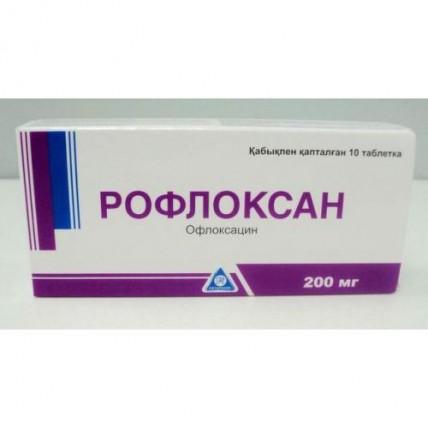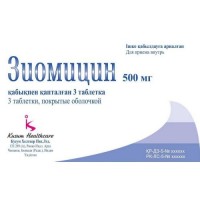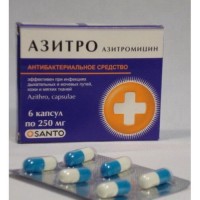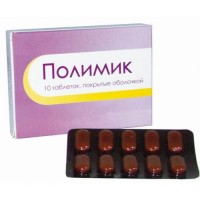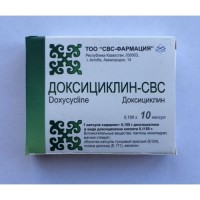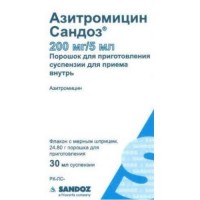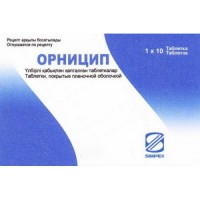Rofloksan 10s 200 mg coated tablets
- $15.20
Sku:
d085ac9fba6b
Ingredient:
Ofloxacin
The instruction for medical use
of ROFLOKSAN medicine
the Trade name
Rofloksan
Mezhdunarodnoye the unlicensed
name Ofloxacin Dosage Form
of the Tablet, coated, 200 mg
Structure
One tablet contains
active agent - ofloxacin of 200 mg,
excipients: corn starch, lactoses monohydrate, sodium of a kroskarmelloz, hydroksipropilmetiltsellyuloz of E6, magnesium stearate,
structure of a cover: hydroksipropilmetiltsellyuloza of E6, polyethyleneglycol 6000, titan dioxide (E 171).
Description
Round biconvex tablets, coated, white or almost white color.
Pharmacotherapeutic group
Antimicrobial drugs – derivatives of a hinolon. Ftorkhinolona.
The code of automatic telephone exchange J01MA01
the Pharmacological
Pharmacokinetics Well properties is soaked up in a gastro intestinal path (absorption – 95%). Bioavailability – over 96%. Communication with proteins of plasma – 25%. The maximum concentration at oral administration makes 1-2 h: after single dose of 200 mg and 400 mg it makes 2.5 mkg/ml and
5 mkg/ml respectively.
About 5% are metabolized in a liver. Elimination half-life makes 4.5-7 h (irrespective of a dose). It is brought out of an organism by kidneys in not changed type of 75-90%, with excrements – about 4%.
Rofloksan's pharmacodynamics – antimicrobial, bactericidal drug of a broad spectrum of activity from group of ftorkhinolon. Inhibits DNK-girazu, breaks DNA synthesis, growth and division of bacteria, causes structural changes of cytoplasm and death of microorganisms.
Ofloxacin influences mainly gram-negative and some gram-positive microorganisms. It is active concerning the microorganisms resistant to the majority of antibiotics and sulfanamide drugs.
Are highly sensitive to drug: E.coli, Klebsiella spp., including Klebsiella pneumonia, Proteus mirabilis, Proteus vilgaris, Serratia spp., Enterobacter spp., Hafnia., Providencia spp., Citrobacret spp., Salmonella spp., Shigella spp., including Shigella sonne., Yersinia spp., Campyloacter jejuni, Pseudomonas aeruginosa, Vibrio cholerae, Vibrio parahaemolyticus, Neiseria gonorrhoeae, Neiseria meningitides, Haemophilus influenzae, Haemophilus ducreyi, Aeromonas hydrophila, Bordetella parapertussis, Bordetella pertussis, Moraxella catarrhalis, Propionibactrium asne, Staphylococcus spp., Staphylococcus aureus, Legionella spp., Brucella spp., Chlamidia trachoatis, Mycoplasma spp., fast-growing atypical mycobacteria and also the bacteria developing beta lactamelements.
Are moderately sensitive: Acinetobacter spp., Enterococci, Steptococccus spp. (including pneumococci), Clostridium perfringens, Corynebacterium spp., Campylobacter spp., Helicobacter pilori, Listeria monocytogenes, Gardnerella vaginalis, Mycobacterium tuberculosis, Ureaplasma urealyticum.
Are resistant to drug: Nocardia asteroidis, anaerobic bacteria (for example, Bacteroidis spp., Peptococcus spp., Peptostreptococcus spp., Enbacter spp., Fusobacterium spp., Clostridium dificile). Does not affect Treponema pallidum.
Indications
- bronchitis, pneumonia
- sinusitis, pharyngitis, average otitis, laryngitis, tracheitis
- infections of skin and soft tissues
- infections of bones and joints
- infectious and inflammatory diseases of an abdominal cavity (including infections of a GIT and biliary tract, except for bacterial enteritis)
- infections of kidneys (pyelonephritis) and urinary tract (cystitis, an urethritis)
- infections of bodies of a small pelvis (endometritis, a salpingitis, an oophoritis, a cervicitis, a parametritis, prostatitis) and genitals (colpitis, an orchitis, an epididymite)
- gonorrhea
- clamidiosis
- meningitis
- prevention of infections at patients with disturbance of the immune status (including at a neutropenia)
accept the Route of administration and Rofloksan's doses inside, without chewing, to or at meal time, washing down with water.
Doses are selected individually depending on localization and weight of a course of an infection and also sensitivity of microorganisms, the general condition of the patient and function of a liver and kidneys.
Adult: on 200-400 mg a day 2 times a day. Course of treatment: 7-10 days. It is possible to appoint a dose up to 400 mg a day in one step, it is preferable in the morning. Daily dose: 200-800 mg.
In gonorrhea: 400 mg once.
At patients with renal failures (at KK of 50-20 ml/min.) the single dose has to make 50% of an average dose at frequency rate of appointment 2 times a day, or the full single dose is entered 1 time a day. At KK less than 20 ml/min. a single dose – 200 mg, then – on 100 mg a day every other day.
At a hemodialysis and peritoneal dialysis: on 100 mg of each 24 h. The maximum daily dose in a liver failure makes 400 mg.
Duration of a course of treatment is defined by sensitivity of the activator and a clinical picture, it is necessary to continue treatment at least 3 more days after disappearance of symptoms of a disease and full normalization of temperature.
At treatment of a salmonellosis the course of treatment makes 1-8 days, in uncomplicated infections of the lower urinary tract: 3-5 days.
Side effects
- anorexia, nausea, vomiting, a meteorism, abdominal pains, a gastralgia,
increase in activity of hepatic transaminases, a hyperbilirubinemia,
cholestatic jaundice, diarrhea, a pseudomembranous coloenteritis
- a headache, dizzinesses, an incoordination of movements,
a tremor, spasms, numbness and paresthesias of extremities, dreadful
dreams, psychotic reactions, uneasiness, psychomotor
excitement, phobias, a depression, confusion of consciousness, a hallucination,
increase in intracranial pressure
- disturbance of color perception, a diplopia, disturbance of taste, sense of smell and
balance
- the tendinitis, myalgias, arthralgias, tendosinovit, the rupture of a sinew
- tachycardia, decrease in the ABP (at sharp decrease in the ABP the introduction
is stopped), collapse, a vasculitis, lengthening of an interval of QT on the ECG
- a leukopenia, an agranulocytosis, anemia, including hemolytic and
aplastic anemia, thrombocytopenia, a pancytopenia
- acute interstitial nephrite, a renal failure,
a giperkreatininemiya, increase in content of urea in serum
- dot hemorrhages, violent hemorrhagic, dermatitis,
- skin rash, an itching, a small tortoiseshell, an allergic pneumonitis,
allergic nephrite, an eosinophilia, fever, a Quincke's edema, a bronchospasm,
Stephens-Johnson's syndrome, a Lyell's disease, a photosensitization,
a multiformny exudative erythema, an acute anaphylaxis
- dysbacteriosis, superinfection
- a hypoglycemia (at patients with diabetes)
-
the Contraindication vaginitis
- hypersensitivity to an ofloksatsin and auxiliary components of drug
- deficit glyukozo-6-fosfatdegidrogenazy
- epilepsy (including in the anamnesis)
- reduction of the threshold of convulsive readiness (including after a craniocereberal
injury, a stroke or inflammatory processes in central nervous system)
- pregnancy and the period of a lactation
- children's and teenage age up to 18 years (before completion of growth of bones of a skeleton)
Medicinal interactions
should not be accepted Rofloksan along with antiacid means or ferriferous drugs in order to avoid decrease in efficiency.
At simultaneous use, ofloxacin reduces clearance of theophylline by 25% (at simultaneous use it is necessary to lower a theophylline dose).
Cimetidinum, furosemide, a methotrexate and drugs blocking calcium channels increase concentration of an ofloksatsin in plasma.
Ofloxacin increases concentration of glibenclamide in plasma.
At a concomitant use with indirect anticoagulants - antagonists of vitamin K it is necessary to exercise control of a condition of a coagulant system of blood.
At combined use with the non-steroidal anti-inflammatory drugs (NPVS) derivative of a nitroimidazole and methylxanthines the risk of development of neurotoxic effects increases.
At co-administration with glucocorticosteroids the risk of a rupture of sinews, especially at elderly people increases.
When assigning with the drugs alkalizing urine (karboangidraza inhibitors, citrates, sodium bicarbonate), the risk of a crystalluria and nephrotoxic effects increases.
Special instructions
Rofloksan is not choice drug in the pneumonia caused by pneumococci. Not shown at treatment of acute tonsillitis.
In before treatment it is impossible to take alcohol, it is not recommended to be affected by sunshine, to radiation by UV rays (quartz-mercury bathtubs, a sunbed).
At drug use the women are not recommended to use tampons, in connection with the increased risk of developing a thrush. In case of side effects from central nervous system, allergic reactions, pseudomembranous colitis it is necessary drug withdrawal. In the pseudomembranous colitis confirmed kolonoskopichesk and/or histologically the oral prescribing of Vancomycinum and metronidazole is shown.
With care to appoint the patient with atherosclerosis of vessels head a brain, disturbances of cerebral circulation (in the anamnesis), chronic kidney disease, organic lesions of the central nervous system, lengthening of intervals of QT.
Against the background of treatment the deterioration in a course of a myasthenia, increase of attacks of a porphyria at predisposed patients is possible.
Seldom arising tendinitis can lead to a rupture of sinews (mainly an Achilles tendon), especially at elderly patients. In case of symptoms of a tendinitis, it is necessary to stop immediately treatment, to make an immobilization and to consult with the orthopedist.
Drug can result in false-negative results at bacteriological diagnosis of tuberculosis (interferes with Mycobacterium tuberculosis discharge).
At patients with abnormal liver functions or kidneys control of concentration of an ofloksatsin in plasma is necessary. In a heavy renal and liver failure the risk of development of toxic effects increases (dose adjustment is required).
The feature of influence of medicine on ability to run the vehicle or potentially dangerous mechanisms
At Rofloksan's use should abstain from occupations potentially dangerous types of activity requiring special attention and speed of psychomotor reactions.
Overdose
Symptoms: drowsiness, nausea, vomiting, dizziness, block, disorientation, confusion of consciousness.
Treatment: gastric lavage, purpose of symptomatic therapy.
A form of release and packing
of the Tablet, coated, 200 mg
On 5 tablets in blister strip packaging from a film of polyvinylchloride and aluminum foil.
On the 2nd blister strip packagings together with the instruction for medical use in the state and Russian languages place in a pack from cardboard.
To Store storage conditions in the dry, protected from light place at a temperature not above 30ºC to Store out of children's reach!
3 years
not to apply a period of storage after an expiration date.
Prescription status
According to the prescription
the Producer
the Owner of a trademark and the certificate of registration is
the ROTAFARM companies, Great Britain
("ROTAPHARM", Great Britain).
SEDIKO Pharmaceutical Co is made ".", Egypt
("SEDICO Pharmaceutical Co.", Egypt)
Ph. / fax: 8 (7272) 529090
www.worldmedicine.kz
to Develop the Address of the organization accepting in the territory of the Republic of Kazakhstan claims from the consumer on quality of products (goods) of RK Almaty, Suyunbaya 222 St. of B
of ROFLOKSAN medicine
the Trade name
Rofloksan
Mezhdunarodnoye the unlicensed
name Ofloxacin Dosage Form
of the Tablet, coated, 200 mg
Structure
One tablet contains
active agent - ofloxacin of 200 mg,
excipients: corn starch, lactoses monohydrate, sodium of a kroskarmelloz, hydroksipropilmetiltsellyuloz of E6, magnesium stearate,
structure of a cover: hydroksipropilmetiltsellyuloza of E6, polyethyleneglycol 6000, titan dioxide (E 171).
Description
Round biconvex tablets, coated, white or almost white color.
Pharmacotherapeutic group
Antimicrobial drugs – derivatives of a hinolon. Ftorkhinolona.
The code of automatic telephone exchange J01MA01
the Pharmacological
Pharmacokinetics Well properties is soaked up in a gastro intestinal path (absorption – 95%). Bioavailability – over 96%. Communication with proteins of plasma – 25%. The maximum concentration at oral administration makes 1-2 h: after single dose of 200 mg and 400 mg it makes 2.5 mkg/ml and
5 mkg/ml respectively.
About 5% are metabolized in a liver. Elimination half-life makes 4.5-7 h (irrespective of a dose). It is brought out of an organism by kidneys in not changed type of 75-90%, with excrements – about 4%.
Rofloksan's pharmacodynamics – antimicrobial, bactericidal drug of a broad spectrum of activity from group of ftorkhinolon. Inhibits DNK-girazu, breaks DNA synthesis, growth and division of bacteria, causes structural changes of cytoplasm and death of microorganisms.
Ofloxacin influences mainly gram-negative and some gram-positive microorganisms. It is active concerning the microorganisms resistant to the majority of antibiotics and sulfanamide drugs.
Are highly sensitive to drug: E.coli, Klebsiella spp., including Klebsiella pneumonia, Proteus mirabilis, Proteus vilgaris, Serratia spp., Enterobacter spp., Hafnia., Providencia spp., Citrobacret spp., Salmonella spp., Shigella spp., including Shigella sonne., Yersinia spp., Campyloacter jejuni, Pseudomonas aeruginosa, Vibrio cholerae, Vibrio parahaemolyticus, Neiseria gonorrhoeae, Neiseria meningitides, Haemophilus influenzae, Haemophilus ducreyi, Aeromonas hydrophila, Bordetella parapertussis, Bordetella pertussis, Moraxella catarrhalis, Propionibactrium asne, Staphylococcus spp., Staphylococcus aureus, Legionella spp., Brucella spp., Chlamidia trachoatis, Mycoplasma spp., fast-growing atypical mycobacteria and also the bacteria developing beta lactamelements.
Are moderately sensitive: Acinetobacter spp., Enterococci, Steptococccus spp. (including pneumococci), Clostridium perfringens, Corynebacterium spp., Campylobacter spp., Helicobacter pilori, Listeria monocytogenes, Gardnerella vaginalis, Mycobacterium tuberculosis, Ureaplasma urealyticum.
Are resistant to drug: Nocardia asteroidis, anaerobic bacteria (for example, Bacteroidis spp., Peptococcus spp., Peptostreptococcus spp., Enbacter spp., Fusobacterium spp., Clostridium dificile). Does not affect Treponema pallidum.
Indications
- bronchitis, pneumonia
- sinusitis, pharyngitis, average otitis, laryngitis, tracheitis
- infections of skin and soft tissues
- infections of bones and joints
- infectious and inflammatory diseases of an abdominal cavity (including infections of a GIT and biliary tract, except for bacterial enteritis)
- infections of kidneys (pyelonephritis) and urinary tract (cystitis, an urethritis)
- infections of bodies of a small pelvis (endometritis, a salpingitis, an oophoritis, a cervicitis, a parametritis, prostatitis) and genitals (colpitis, an orchitis, an epididymite)
- gonorrhea
- clamidiosis
- meningitis
- prevention of infections at patients with disturbance of the immune status (including at a neutropenia)
accept the Route of administration and Rofloksan's doses inside, without chewing, to or at meal time, washing down with water.
Doses are selected individually depending on localization and weight of a course of an infection and also sensitivity of microorganisms, the general condition of the patient and function of a liver and kidneys.
Adult: on 200-400 mg a day 2 times a day. Course of treatment: 7-10 days. It is possible to appoint a dose up to 400 mg a day in one step, it is preferable in the morning. Daily dose: 200-800 mg.
In gonorrhea: 400 mg once.
At patients with renal failures (at KK of 50-20 ml/min.) the single dose has to make 50% of an average dose at frequency rate of appointment 2 times a day, or the full single dose is entered 1 time a day. At KK less than 20 ml/min. a single dose – 200 mg, then – on 100 mg a day every other day.
At a hemodialysis and peritoneal dialysis: on 100 mg of each 24 h. The maximum daily dose in a liver failure makes 400 mg.
Duration of a course of treatment is defined by sensitivity of the activator and a clinical picture, it is necessary to continue treatment at least 3 more days after disappearance of symptoms of a disease and full normalization of temperature.
At treatment of a salmonellosis the course of treatment makes 1-8 days, in uncomplicated infections of the lower urinary tract: 3-5 days.
Side effects
- anorexia, nausea, vomiting, a meteorism, abdominal pains, a gastralgia,
increase in activity of hepatic transaminases, a hyperbilirubinemia,
cholestatic jaundice, diarrhea, a pseudomembranous coloenteritis
- a headache, dizzinesses, an incoordination of movements,
a tremor, spasms, numbness and paresthesias of extremities, dreadful
dreams, psychotic reactions, uneasiness, psychomotor
excitement, phobias, a depression, confusion of consciousness, a hallucination,
increase in intracranial pressure
- disturbance of color perception, a diplopia, disturbance of taste, sense of smell and
balance
- the tendinitis, myalgias, arthralgias, tendosinovit, the rupture of a sinew
- tachycardia, decrease in the ABP (at sharp decrease in the ABP the introduction
is stopped), collapse, a vasculitis, lengthening of an interval of QT on the ECG
- a leukopenia, an agranulocytosis, anemia, including hemolytic and
aplastic anemia, thrombocytopenia, a pancytopenia
- acute interstitial nephrite, a renal failure,
a giperkreatininemiya, increase in content of urea in serum
- dot hemorrhages, violent hemorrhagic, dermatitis,
- skin rash, an itching, a small tortoiseshell, an allergic pneumonitis,
allergic nephrite, an eosinophilia, fever, a Quincke's edema, a bronchospasm,
Stephens-Johnson's syndrome, a Lyell's disease, a photosensitization,
a multiformny exudative erythema, an acute anaphylaxis
- dysbacteriosis, superinfection
- a hypoglycemia (at patients with diabetes)
-
the Contraindication vaginitis
- hypersensitivity to an ofloksatsin and auxiliary components of drug
- deficit glyukozo-6-fosfatdegidrogenazy
- epilepsy (including in the anamnesis)
- reduction of the threshold of convulsive readiness (including after a craniocereberal
injury, a stroke or inflammatory processes in central nervous system)
- pregnancy and the period of a lactation
- children's and teenage age up to 18 years (before completion of growth of bones of a skeleton)
Medicinal interactions
should not be accepted Rofloksan along with antiacid means or ferriferous drugs in order to avoid decrease in efficiency.
At simultaneous use, ofloxacin reduces clearance of theophylline by 25% (at simultaneous use it is necessary to lower a theophylline dose).
Cimetidinum, furosemide, a methotrexate and drugs blocking calcium channels increase concentration of an ofloksatsin in plasma.
Ofloxacin increases concentration of glibenclamide in plasma.
At a concomitant use with indirect anticoagulants - antagonists of vitamin K it is necessary to exercise control of a condition of a coagulant system of blood.
At combined use with the non-steroidal anti-inflammatory drugs (NPVS) derivative of a nitroimidazole and methylxanthines the risk of development of neurotoxic effects increases.
At co-administration with glucocorticosteroids the risk of a rupture of sinews, especially at elderly people increases.
When assigning with the drugs alkalizing urine (karboangidraza inhibitors, citrates, sodium bicarbonate), the risk of a crystalluria and nephrotoxic effects increases.
Special instructions
Rofloksan is not choice drug in the pneumonia caused by pneumococci. Not shown at treatment of acute tonsillitis.
In before treatment it is impossible to take alcohol, it is not recommended to be affected by sunshine, to radiation by UV rays (quartz-mercury bathtubs, a sunbed).
At drug use the women are not recommended to use tampons, in connection with the increased risk of developing a thrush. In case of side effects from central nervous system, allergic reactions, pseudomembranous colitis it is necessary drug withdrawal. In the pseudomembranous colitis confirmed kolonoskopichesk and/or histologically the oral prescribing of Vancomycinum and metronidazole is shown.
With care to appoint the patient with atherosclerosis of vessels head a brain, disturbances of cerebral circulation (in the anamnesis), chronic kidney disease, organic lesions of the central nervous system, lengthening of intervals of QT.
Against the background of treatment the deterioration in a course of a myasthenia, increase of attacks of a porphyria at predisposed patients is possible.
Seldom arising tendinitis can lead to a rupture of sinews (mainly an Achilles tendon), especially at elderly patients. In case of symptoms of a tendinitis, it is necessary to stop immediately treatment, to make an immobilization and to consult with the orthopedist.
Drug can result in false-negative results at bacteriological diagnosis of tuberculosis (interferes with Mycobacterium tuberculosis discharge).
At patients with abnormal liver functions or kidneys control of concentration of an ofloksatsin in plasma is necessary. In a heavy renal and liver failure the risk of development of toxic effects increases (dose adjustment is required).
The feature of influence of medicine on ability to run the vehicle or potentially dangerous mechanisms
At Rofloksan's use should abstain from occupations potentially dangerous types of activity requiring special attention and speed of psychomotor reactions.
Overdose
Symptoms: drowsiness, nausea, vomiting, dizziness, block, disorientation, confusion of consciousness.
Treatment: gastric lavage, purpose of symptomatic therapy.
A form of release and packing
of the Tablet, coated, 200 mg
On 5 tablets in blister strip packaging from a film of polyvinylchloride and aluminum foil.
On the 2nd blister strip packagings together with the instruction for medical use in the state and Russian languages place in a pack from cardboard.
To Store storage conditions in the dry, protected from light place at a temperature not above 30ºC to Store out of children's reach!
3 years
not to apply a period of storage after an expiration date.
Prescription status
According to the prescription
the Producer
the Owner of a trademark and the certificate of registration is
the ROTAFARM companies, Great Britain
("ROTAPHARM", Great Britain).
SEDIKO Pharmaceutical Co is made ".", Egypt
("SEDICO Pharmaceutical Co.", Egypt)
Ph. / fax: 8 (7272) 529090
www.worldmedicine.kz
to Develop the Address of the organization accepting in the territory of the Republic of Kazakhstan claims from the consumer on quality of products (goods) of RK Almaty, Suyunbaya 222 St. of B
